Alberta’s healthcare system is undergoing its most significant transformation in decades. Premier Danielle Smith announced the creation of 14 regional health councils across the province, marking a decisive shift away from the centralized Alberta Health Services model that has dominated since 2008.
At a press conference in Red Deer last Thursday, Smith framed the move as bringing healthcare decisions “closer to the communities they impact.” The new councils will begin work immediately, with full implementation expected by April 2025.
For many Albertans, this restructuring feels familiar. The province operated under regional health authorities until they were consolidated into the single AHS entity 16 years ago. This latest iteration, however, comes with significant differences.
“These aren’t your parents’ health regions,” said Health Minister Adriana LaGrange, who emphasized the councils will focus on local service delivery while core administrative functions remain centralized. “We’re maintaining the efficiency of a unified system while restoring the community responsiveness we lost.”
Each council will have nine members – three appointed by the health minister, three selected from municipally elected officials, and three healthcare professionals from the region. They’ll be tasked with identifying service gaps, improving access to care, and addressing unique regional challenges.
Dr. Verna Yiu, former AHS CEO now teaching health policy at the University of Alberta, sees both promise and potential pitfalls in the approach. “The regional voice is certainly valuable, but success depends on meaningful authority and adequate resources,” she told me during a phone interview. “Without proper funding and decision-making power, these councils risk becoming symbolic rather than transformative.”
This restructuring comes amid mounting healthcare challenges across the province. Emergency department wait times have increased by 36% since 2019, according to AHS’s own quarterly performance reports. Rural communities continue facing physician shortages, with 21 communities experiencing disruptions to emergency services last month alone.
In Stettler, where one of the new regional councils will operate, Mayor Sean Nolls expressed cautious optimism. “We’ve been advocating for years to have more say in how healthcare is delivered here. The proof will be in what resources follow this announcement.”
The financial implications remain somewhat murky. The government has allocated $85 million for the transition, but critics question whether this represents new funding or simply redistributed health dollars. Opposition health critic Luanne Metz called the move “reorganization without reinvestment” during question period on Monday.
For everyday Albertans like Sarah Kowalchuk, a mother of three in Lethbridge, the announcement generates both hope and skepticism. “I’ve spent enough nights in emergency with my kids to know the system needs help,” she said while attending a community forum last weekend. “But I’ve also lived through enough government reorganizations to wonder if this will actually improve things when we need to see a doctor.”
Healthcare unions have responded with measured concern. United Nurses of Alberta president Heather Smith warned against fragmentation of services while acknowledging potential benefits of regional input. “Our members want to ensure this doesn’t disrupt collective agreements or create inconsistent working conditions across regions,” she noted in a statement.
The government’s timeline appears ambitious. Regional chairs will be appointed by next month, with councils expected to complete initial needs assessments by December. Full operational authority transitions in spring 2025.
Public health experts point to both successes and failures in other provinces that maintain regional health structures. British Columbia’s experience suggests regional models can improve community engagement but still struggle with the same fundamental challenges of funding constraints and human resource shortages.
“The structure matters less than the resources and policy direction,” explains Dr. Tom Noseworthy, healthcare policy expert at the University of Calgary. “Redrawing organizational charts doesn’t automatically translate to more doctors, shorter wait times, or better outcomes.”
For indigenous communities, questions remain about how their unique healthcare needs will be addressed. The Maskwacis Health Services, serving four First Nations communities, has requested clarification on how their existing healthcare agreements will integrate with the new regional approach.
Perhaps most telling is the response from healthcare workers themselves. Dr. Samantha Wong, a family physician in Red Deer, summarized the sentiment I heard repeatedly from frontline providers: “We’re willing to give any system a chance that might improve patient care. But after years of restructuring exercises, we’re looking for stability and solutions to the problems we face every day – staffing shortages, burnout, and access blocks.”
As implementation begins, Albertans will watch closely to see whether these councils truly represent a fundamental shift in healthcare delivery or simply another reorganization of a system under pressure. The success of this initiative may ultimately depend less on governance structure and more on whether it addresses the core challenges that have frustrated patients and providers alike.
For a province with a history of healthcare system overhauls, the true measure will be whether Albertans notice improvements where it matters most – in timely access to quality care regardless of postal code.






